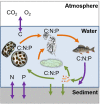Bridging Food Webs, Ecosystem Metabolism, and Biogeochemistry Using Ecological Stoichiometry Theory
- PMID: 28747904
- PMCID: PMC5507128
- DOI: 10.3389/fmicb.2017.01298
Bridging Food Webs, Ecosystem Metabolism, and Biogeochemistry Using Ecological Stoichiometry Theory
Abstract
Although aquatic ecologists and biogeochemists are well aware of the crucial importance of ecosystem functions, i.e., how biota drive biogeochemical processes and vice-versa, linking these fields in conceptual models is still uncommon. Attempts to explain the variability in elemental cycling consequently miss an important biological component and thereby impede a comprehensive understanding of the underlying processes governing energy and matter flow and transformation. The fate of multiple chemical elements in ecosystems is strongly linked by biotic demand and uptake; thus, considering elemental stoichiometry is important for both biogeochemical and ecological research. Nonetheless, assessments of ecological stoichiometry (ES) often focus on the elemental content of biota rather than taking a more holistic view by examining both elemental pools and fluxes (e.g., organismal stoichiometry and ecosystem process rates). ES theory holds the promise to be a unifying concept to link across hierarchical scales of patterns and processes in ecology, but this has not been fully achieved. Therefore, we propose connecting the expertise of aquatic ecologists and biogeochemists with ES theory as a common currency to connect food webs, ecosystem metabolism, and biogeochemistry, as they are inherently concatenated by the transfer of carbon, nitrogen, and phosphorous through biotic and abiotic nutrient transformation and fluxes. Several new studies exist that demonstrate the connections between food web ecology, biogeochemistry, and ecosystem metabolism. In addition to a general introduction into the topic, this paper presents examples of how these fields can be combined with a focus on ES. In this review, a series of concepts have guided the discussion: (1) changing biogeochemistry affects trophic interactions and ecosystem processes by altering the elemental ratios of key species and assemblages; (2) changing trophic dynamics influences the transformation and fluxes of matter across environmental boundaries; (3) changing ecosystem metabolism will alter the chemical diversity of the non-living environment. Finally, we propose that using ES to link nutrient cycling, trophic dynamics, and ecosystem metabolism would allow for a more holistic understanding of ecosystem functions in a changing environment.
Keywords: carbon quality; ecological stoichiometry; ecosystem function; element cycling; energy transfer; nutrient dynamics; trophic interactions.
Figures



Similar articles
-
Ecological Stoichiometry for Parasitologists.Trends Parasitol. 2018 Nov;34(11):928-933. doi: 10.1016/j.pt.2018.07.008. Epub 2018 Aug 10. Trends Parasitol. 2018. PMID: 30104137 Review.
-
Stoichiometric distribution models: ecological stoichiometry at the landscape extent.Ecol Lett. 2017 Dec;20(12):1495-1506. doi: 10.1111/ele.12859. Epub 2017 Oct 12. Ecol Lett. 2017. PMID: 29027338
-
Consumer-driven nutrient dynamics in freshwater ecosystems: from individuals to ecosystems.Biol Rev Camb Philos Soc. 2017 Nov;92(4):2003-2023. doi: 10.1111/brv.12318. Epub 2016 Dec 23. Biol Rev Camb Philos Soc. 2017. PMID: 28008706 Review.
-
Trophic-dynamic considerations in relating species diversity to ecosystem resilience.Biol Rev Camb Philos Soc. 2000 Aug;75(3):347-76. doi: 10.1017/s0006323100005508. Biol Rev Camb Philos Soc. 2000. PMID: 11034015 Review.
-
Nutrient and stoichiometry dynamics of decomposing litter in stream ecosystems: A global synthesis.Ecology. 2023 Jul;104(7):e4060. doi: 10.1002/ecy.4060. Epub 2023 May 10. Ecology. 2023. PMID: 37186091
Cited by
-
Ecosystem metabolism drives pH variability and modulates long-term ocean acidification in the Northeast Pacific coastal ocean.Sci Rep. 2019 Jan 30;9(1):963. doi: 10.1038/s41598-018-37764-4. Sci Rep. 2019. PMID: 30700764 Free PMC article.
-
Biological trade-offs underpin coral reef ecosystem functioning.Nat Ecol Evol. 2022 Jun;6(6):701-708. doi: 10.1038/s41559-022-01710-5. Epub 2022 Apr 4. Nat Ecol Evol. 2022. PMID: 35379939
-
Quantitative principles of microbial metabolism shared across scales.Nat Microbiol. 2024 Aug;9(8):1940-1953. doi: 10.1038/s41564-024-01764-0. Epub 2024 Aug 6. Nat Microbiol. 2024. PMID: 39107418 Review.
-
Contrasts among cationic phytochemical landscapes in the southern United States.Plant Environ Interact. 2022 Oct 4;3(5):226-241. doi: 10.1002/pei3.10093. eCollection 2022 Oct. Plant Environ Interact. 2022. PMID: 37283990 Free PMC article.
-
Stoichiometric multitrophic networks reveal significance of land-sea interaction to ecosystem function in a subtropical nutrient-poor bight, South Africa.PLoS One. 2019 Jan 7;14(1):e0210295. doi: 10.1371/journal.pone.0210295. eCollection 2019. PLoS One. 2019. PMID: 30615659 Free PMC article.
References
-
- Alexander R. B., Smith R. A. (2006). Trends in the nutrient enrichment of US rivers during the late 20th century and their relation to changes in probable stream trophic conditions. Limnol. Oceanogr. 51 639–654. 10.4319/lo.2006.51.1_part_2.0639 - DOI
Publication types
LinkOut - more resources
Full Text Sources
Other Literature Sources

